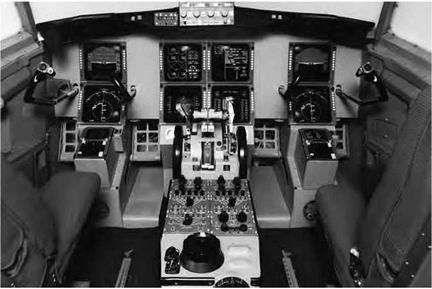Glass Cockpit
As aircraft systems became more complex and the amount of navigation, weather, and air traffic information available to pilots grew in abundance, the nostalgic days of "stick and rudder” men (and women) gave way to "cockpit managers.” Mechanical, analog dials showing a
|
A prototype "glass cockpit” that replaces analog dials and mechanical tapes with digitally driven flat panel displays is installed inside the cabin of NASA’s 737 airborne laboratory, which tested the new hardware and won support for the concept in the aviation community. NASA. |
single piece of information (e. g., airspeed or altitude) weren’t sufficient to give pilots the full status of their increasingly complicated aircraft flying in an increasingly crowded sky. The solution came from engineers at NASA’s Langley Research Center in Hampton, VA, who worked with key industry partners to come up with an electronic flight display—what is generally known now as the glass cockpit—that took advantage of powerful, small computers and liquid crystal display (LCD) flat panel technology. Early concepts of the glass cockpit were flight-proven using NASA’s Boeing 737 flying laboratory and eventually certified for use by the FAA.[233]
According to a NASA fact sheet,
The success of the NASA-led glass cockpit work is reflected in the total acceptance of electronic flight displays beginning with the introduction of the Boeing 767 in 1982. Airlines and their passengers, alike, have benefitted. Safety and efficiency of flight have been increased with improved pilot understanding of the airplane’s situation relative to its environment.
The cost of air travel is less than it would be with the old technology and more flights arrive on time.[234]
After developing the first glass cockpits capable of displaying basic flight information, NASA has continued working to make more information available to the pilots,[235] while at the same time being conscious of information overload,[236] the ability of the flight crew to operate the cockpit displays without distraction during critical phases of flight (takeoff and landing),[237] and the effectiveness of training pilots to use the glass cockpit.[238]











